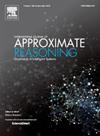Distributed fusion-based algorithms for learning high-dimensional Bayesian Networks: Testing ring and star topologies
IF 3.2
3区 计算机科学
Q2 COMPUTER SCIENCE, ARTIFICIAL INTELLIGENCE
引用次数: 0
Abstract
Learning Bayesian Networks (BNs) from high-dimensional data is a complex and time-consuming task. Although there are approaches based on horizontal (instances) or vertical (variables) partitioning in the literature, none can guarantee the same theoretical properties as the Greedy Equivalence Search (GES) algorithm, except those based on the GES algorithm itself. This paper proposes a parallel distributed framework that uses GES as its local learning algorithm, obtaining results similar to those of GES and guaranteeing its theoretical properties but requiring less execution time. The framework involves splitting the set of all possible edges into clusters and constraining each framework node to only work with the received subset of edges. The global learning process is an iterative algorithm that carries out rounds until a convergence criterion is met. We have designed a ring and a star topology to distribute node connections. Regardless of the topology, each node receives a BN as input; it then fuses it with its own BN model and uses the result as the starting point for a local learning process, limited to its own subset of edges. Once finished, the result is then sent to another node as input. Experiments were carried out on a large repertory of domains, including large BNs up to more than 1000 variables. Our results demonstrate our proposal's effectiveness compared to GES and its fast version (fGES), generating high-quality BNs in less execution time.
基于分布式融合的高维贝叶斯网络学习算法:测试环形和星形拓扑结构
从高维数据中学习贝叶斯网络(BN)是一项复杂而耗时的任务。虽然文献中有基于水平(实例)或垂直(变量)划分的方法,但除了基于 GES 算法本身的方法外,没有一种方法能保证与贪婪等价搜索(GES)算法相同的理论属性。本文提出了一种并行分布式框架,该框架使用 GES 作为本地学习算法,可获得与 GES 类似的结果,并保证其理论属性,但所需执行时间较少。该框架包括将所有可能的边集分割成群,并限制每个框架节点只能处理接收到的边子集。全局学习过程是一种迭代算法,在达到收敛标准之前会进行一轮又一轮的学习。我们设计了环形和星形拓扑结构来分配节点连接。无论采用哪种拓扑结构,每个节点都会接收一个 BN 作为输入;然后将其与自己的 BN 模型融合,并将结果作为局部学习过程的起点,但仅限于自己的边子集。一旦完成,结果就会作为输入发送到另一个节点。我们在大量领域进行了实验,包括多达 1000 多个变量的大型 BN。结果表明,与 GES 及其快速版本(fGES)相比,我们的建议非常有效,能在更短的执行时间内生成高质量的 BN。
本文章由计算机程序翻译,如有差异,请以英文原文为准。
求助全文
约1分钟内获得全文
求助全文
来源期刊

International Journal of Approximate Reasoning
工程技术-计算机:人工智能
CiteScore
6.90
自引率
12.80%
发文量
170
审稿时长
67 days
期刊介绍:
The International Journal of Approximate Reasoning is intended to serve as a forum for the treatment of imprecision and uncertainty in Artificial and Computational Intelligence, covering both the foundations of uncertainty theories, and the design of intelligent systems for scientific and engineering applications. It publishes high-quality research papers describing theoretical developments or innovative applications, as well as review articles on topics of general interest.
Relevant topics include, but are not limited to, probabilistic reasoning and Bayesian networks, imprecise probabilities, random sets, belief functions (Dempster-Shafer theory), possibility theory, fuzzy sets, rough sets, decision theory, non-additive measures and integrals, qualitative reasoning about uncertainty, comparative probability orderings, game-theoretic probability, default reasoning, nonstandard logics, argumentation systems, inconsistency tolerant reasoning, elicitation techniques, philosophical foundations and psychological models of uncertain reasoning.
Domains of application for uncertain reasoning systems include risk analysis and assessment, information retrieval and database design, information fusion, machine learning, data and web mining, computer vision, image and signal processing, intelligent data analysis, statistics, multi-agent systems, etc.
 求助内容:
求助内容: 应助结果提醒方式:
应助结果提醒方式:


